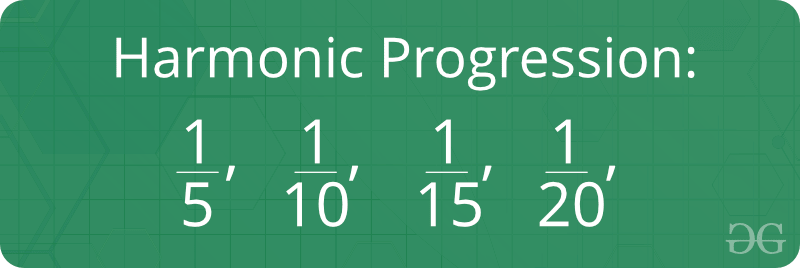如果项的倒数在AP中,则数字序列称为和声级数。简而言之,如果1 / a,1 / b,1 / c,1 / d,1 / e,1 / f在AP中,则a,b,c,d,e,f在HP中。例如,1 / a,1 /(a + d),1 /(a + 2d)等位于HP中,因为a,a + d,a + 2d位于AP中。 
关于谐波发展的事实:
- 为了解决调和级数问题,应制作相应的AP系列,然后再解决该问题。
- 由于AP的n项由an = a +(n-1)d给出,因此HP的n项由1 / [a +(n -1)d]给出。
- 对于两个数,如果A,G和H分别是算术,几何和调和平均值,则
- A≥G≥H
- AH = G 2 ,即A,G,H在GP中
- 如果我们需要在HP中找到三个数字,则应将其假定为1 / a–d,1 / a,1 / a + d
- 通过首先将它们转换为AP可以解决HP的大多数问题
谐波渐进公式: 
我们如何检查一个系列是否为谐波级数?
这个想法是使给定的数组或序列倒数。倒数后,检查连续元素之间的差异是否相同。如果所有差异都相同,则可以进行算术级数运算。因此,我们知道这些项的倒数是否在AP中,那么给定一系列序列在HP中。让我们以1 / 5、1 / 10、1 / 15、1 / 20、1 / 25为序列,并检查是否为谐波的进展与否。下面是实现:
C++
// CPP program to check if a given
// array can form harmonic progression
#include
using namespace std;
bool checkIsHP(vector &arr)
{
int n = arr.size();
if (n == 1)
{
return true;
}
// Find reciprocal of arr[]
vector rec;
for (int i = 0; i < n; i++)
{
rec.push_back((1 / arr[i]));
}
// return (rec);
// After finding reciprocal, check if
// the reciprocal is in A. P.
// To check for A.P., first Sort the
// reciprocal array, then check difference
// between consecutive elements
sort(rec.begin(), rec.end());
int d = (rec[1]) - (rec[0]);
for (int i = 2; i < n; i++)
{
if (rec[i] - rec[i - 1] != d)
{
return false;
}
}
return true;
}
// Driver Code
int main()
{
// series to check whether it is in H.P
vector arr = {1 / 5, 1 / 10, 1 / 15, 1 / 20, 1 / 25};
// Checking a series is in H.P or not
if (checkIsHP(arr))
{
cout << "Yes" << std::endl;
}
else
{
cout << "No" < Java
// Java program to check if a given
// array can form harmonic progression
import java.util.*;
class GFG
{
static boolean checkIsHP(double []arr)
{
int n = arr.length;
if (n == 1)
return true;
// Find reciprocal of arr[]
ArrayList rec = new ArrayList();
for (int i = 0; i < n; i++)
rec.add((int)(1 / arr[i]));
// return (rec);
// After finding reciprocal, check if
// the reciprocal is in A. P.
// To check for A.P., first Sort the
// reciprocal array, then check difference
// between consecutive elements
Collections.sort(rec);
int d = (int)rec.get(1) - (int)rec.get(0);
for (int i = 2; i < n; i++)
if (rec.get(i) - rec.get(i - 1) != d)
return false;
return true;
}
// Driver code
public static void main(String[] args)
{
// series to check whether it is in H.P
double arr[] = { 1/5, 1/10, 1/15,
1/20, 1/25 };
// Checking a series is in H.P or not
if (checkIsHP(arr))
System.out.println("Yes");
else
System.out.println("No");
}
}
// This code is contributed by mits Python3
# Python3 program to check if a given
# array can form harmonic progression
def checkIsHP(arr):
n = len(arr)
if (n == 1):
return True
# Find reciprocal of arr[]
rec = []
for i in range(0, len(arr)):
a = 1 / arr[i]
rec.append(a)
return(rec)
# After finding reciprocal, check if the
# reciprocal is in A. P.
# To check for A.P., first Sort the
# reciprocal array, then check difference
# between consecutive elements
rec.sort()
d = rec[1] - rec[0]
for i in range(2, n):
if (rec[i] - rec[i-1] != d):
return False
return True
# Driver code
if __name__=='__main__':
# series to check whether it is in H.P
arr = [ 1/5, 1/10, 1/15, 1/20, 1/25 ]
# Checking a series is in H.P or not
if (checkIsHP(arr)):
print("Yes")
else:
print("No")C#
// C# program to check if a given
// array can form harmonic progression
using System;
using System.Collections;
class GFG
{
static bool checkIsHP(double[] arr)
{
int n = arr.Length;
if (n == 1)
return true;
// Find reciprocal of arr[]
ArrayList rec = new ArrayList();
for (int i = 0; i < n; i++)
rec.Add((int)(1 / arr[i]));
// return (rec);
// After finding reciprocal, check if
// the reciprocal is in A. P.
// To check for A.P., first Sort the
// reciprocal array, then check difference
// between consecutive elements
rec.Sort();
int d = (int)rec[1] - (int)rec[0];
for (int i = 2; i < n; i++)
if ((int)rec[i] - (int)rec[i - 1] != d)
return false;
return true;
}
// Driver code
public static void Main()
{
// series to check whether it is in H.P
double[] arr = { 1/5, 1/10, 1/15,
1/20, 1/25 };
// Checking a series is in H.P or not
if (checkIsHP(arr))
Console.WriteLine("Yes");
else
Console.WriteLine("No");
}
}
// This code is contributed by mitsPHP
输出:
Yes
时间复杂度: O(n Log n)。
与谐波进行有关的基本程序
- 谐波级数总和
- 查找第N个谐波数的程序
- 级数之和(n / 1)+(n / 2)+(n / 3)+(n / 4)+……。+(n / n)
- 检查给定编号是否为矿石编号
- 直至成功的预期试验次数
最近有关谐波进行的文章!